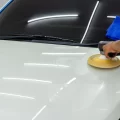Compounding & Glazing: Complete Guide to Reviving Your Vehicle’s Shine
Maintaining a car’s flawless finish involves more than just regular washing or waxing. Over time, exposure to sunlight, dust, road contaminants, and minor scratches can dull the paint and reduce its depth. This is where Compounding & Glazing come into play — essential steps in paint restoration that bring back shine, smoothness, and clarity to your vehicle’s exterior.
In this article, we’ll discuss what Compounding & Glazing are, how they work, the benefits, the process, and why professional detailing can make a noticeable difference.
Understanding Compounding & Glazing
Compounding & Glazing are two key stages in automotive paint correction:
-
Compounding involves using an abrasive product to remove paint imperfections, oxidation, scratches, and swirl marks. It smoothens the surface and restores clarity.
-
Glazing follows compounding and enhances the gloss by filling micro-scratches and improving paint depth. It gives the paint a reflective, mirror-like finish.
Together, these steps restore a vehicle’s shine, making it look freshly detailed and well-maintained.
Why These Steps Matter
Regular driving and environmental exposure gradually deteriorate paint surfaces. Compounding & Glazing are essential to:
-
Bring back lost shine and gloss.
-
Remove minor scratches, swirl marks, and oxidation.
-
Prepare the paint for waxing, sealants, or ceramic coatings.
-
Enhance color depth and reflectivity.
-
Prolong paint life by keeping it smooth and contaminant-free.
By addressing these issues, vehicles retain their aesthetic appeal and maintain resale value.
The Compounding Process
Compounding is the first corrective step, where abrasives remove imperfections and restore a uniform surface.
1. Preparing the Surface
-
Thoroughly wash and dry the vehicle to remove dirt and grime.
-
Clay bar treatment can help remove embedded particles.
2. Selecting the Right Compound
-
Heavy Cut: For deep scratches and severe oxidation.
-
Medium Cut: Ideal for moderate swirl marks or faded paint.
-
Fine Cut: For minor blemishes and finishing touches.
3. Applying the Compound
-
Use a rotary or dual-action polisher for even coverage.
-
Work in small sections using circular motions until defects fade.
4. Inspection
-
Wipe the surface with a microfiber cloth.
-
Check for uniform smoothness and clarity.
Compounding removes a fine layer of clear coat to restore the paint’s original vibrancy and smoothness.
Glazing: Enhancing Depth and Shine
After compounding, glazing adds depth and a polished finish to the paint.
1. Purpose of Glazing
-
Fills micro-scratches and minor imperfections.
-
Improves color depth and clarity.
-
Adds a temporary layer of shine and protection.
2. Types of Glazes
-
Acrylic: High reflectivity with long-lasting shine.
-
Oil-Based: Deepens color and smoothness.
-
Silicone-Based: Creates a glossy, water-repellent surface.
3. How to Apply
-
Apply evenly with a foam applicator or polisher.
-
Let it sit briefly, then buff off excess.
-
Result: A smooth, reflective, and vibrant surface ready for protection.
Compounding & Glazing vs. Polishing
While often confused, these steps differ from standard polishing:
| Step | Purpose | Abrasive Level | Result |
|---|---|---|---|
| Compounding | Remove defects | High | Smooth, even surface |
| Polishing | Refine clarity | Medium | Enhanced gloss |
| Glazing | Add shine and depth | Minimal | Wet-look, reflective finish |
For professional results, many detailers combine all three in a sequence.
Professional vs. DIY Detailing
Although home kits exist for Compounding & Glazing, professional services offer longer-lasting and safer results.
Advantages of Professionals
-
High-quality compounds and glazes.
-
Access to advanced machines for uniform results.
-
Experience in avoiding paint damage.
-
Consistently superior finish across all panels.
DIY Considerations
-
Cost-effective but requires skill.
-
Risk of over-compounding or creating swirl marks.
-
Gloss and durability may be inferior to professional work.
For new or luxury vehicles, professional detailing ensures optimum paint health and mirror-like shine.
Benefits of Compounding & Glazing
-
Restores paint clarity and depth.
-
Removes oxidation, swirl marks, and minor scratches.
-
Prepares the surface for wax, sealants, or ceramic coatings.
-
Gives a “showroom” finish.
-
Protects paint against UV rays and contaminants.
-
Increases resale value of the vehicle.
Regular application maintains both the aesthetic appeal and longevity of the paint.
Maintaining the Gloss After Detailing
To extend the results of Compounding & Glazing:
-
Use pH-neutral car shampoo for washing.
-
Always clean with microfiber cloths to prevent scratches.
-
Avoid direct sunlight during washing or waxing.
-
Reapply protective wax or sealant periodically.
-
Consider professional detailing at least twice yearly.
Proper aftercare ensures the finish remains glossy, reflective, and smooth.
Industries Using Compounding & Glazing
While popular in automotive care, these techniques are applied elsewhere:
-
Marine: Restoring boat hulls and fiberglass surfaces.
-
Aerospace: Maintaining aircraft paint and smoothness.
-
Industrial Equipment: Enhancing machinery and painted panels.
-
Furniture & Metalwork: Achieving smooth, reflective finishes.
Their versatility makes Compounding & Glazing a valuable process in many surface restoration applications.
Conclusion
Compounding & Glazing are vital for restoring, protecting, and enhancing painted surfaces. They remove defects, restore shine, and prepare surfaces for protective coatings, extending the life and beauty of any vehicle.
Whether for everyday cars, luxury vehicles, or industrial equipment, these techniques ensure surfaces remain smooth, glossy, and visually appealing. Professional detailing offers the best results, turning dull, faded paint into a reflective, showroom-quality finish that lasts.










